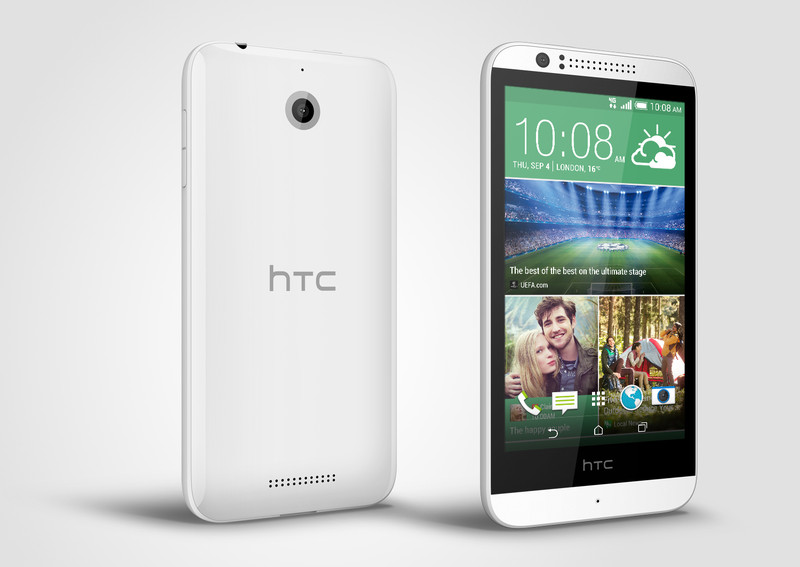HTC Brings ARMv8 ISA To The Low-End With The Desire 510 Smartphone
Today, HTC is announcing the Desire 510, a low cost phone that comes with a 4.7" screen, 854 x 480 resolution (which is a little on the low side), 1 GB of RAM, 8 GB of storage with microSD support up to 128 GB, 5MP rear camera and VGA front camera and 2,100 mAh battery. It's running Android 4.4 with the latest version of Sense on top. The price is not yet known, but given the specs, it should be somewhere around the Moto G level.
What's special about this low-cost phone is that it brings the 64-bit ARMv8 architecture (and all the improvements the architecture brings) to the low end of the market, and it has an integrated LTE modem as well, thanks to Qualcomm's Snapdragon 410 SoC.
Having conquered the high end of the market with its integrated LTE modems, it looks like Qualcomm is preparing to conquer the low end of the market using the same strategy -- even while many of its competitors are still struggling to bring integrated LTE to the high-end.
This strategy has worked quite well for Qualcomm in the past, and there's no reason to believe it won't work again, especially as more carriers upgrade to LTE networks worldwide. HTC is merely the first OEM to adopt Qualcomm's 64-bit chips early, but more devices should be using its low-end and mid-range 64-bit chips soon.
Unfortunately for Qualcomm, its high-end 64-bit chips aren't going to be ready anytime soon, which leaves an opening for both Nvidia and Samsung to steal some market share. In fact, the same company that's pushing for 64-bit Qualcomm chips at the low-end right now, HTC, is also rumored to use Nvidia's upcoming ARMv8-based Denver chip in the Volantis/Nexus 9.
HTC is smart to bet on 64-bit, not just because it's the latest "trend" in mobile chips, but also because it happens to be the future of the ARM architecture, and all chips and devices will transition to ARMv8 over the next few years.
With Android L fully supporting ARMv8, it makes sense for HTC to future-proof its devices so it can deprecate the support for ARMv7 devices sooner and only have to support its ARMv8 devices in the near future. That should make it a lot easier for its development teams, which means we could also see more and faster upgrades for HTC phones once the company only has to deal with one instruction set.
Get Tom's Hardware's best news and in-depth reviews, straight to your inbox.
Follow us @tomshardware, on Facebook and on Google+.
Lucian Armasu is a Contributing Writer for Tom's Hardware US. He covers software news and the issues surrounding privacy and security.
-
dovah-chan They could at least include a 1280 x 720 IPS panel as well. Sleek looking phone though. Still not as gorgeous as my M8 though. I don't think I'll ever get tired of just looking at. ^^"Reply -
Belardo After seeing, holding and feeling the M8 vs the LG G3 - which has a similar shape on the back ... I would go with the LG. The M8 back looks great, you know its metal... and the HK-Version with its gold trim looks very nice. The G3, while it has a plastic feel, the texture kind of works for me. I don't really care for the buttons on the back, but ALL LG phones have these now and yet sales are quite good.Reply
What sells me on the G3 is the front. I've seen demo HTC One/M8s with damaged front metal faces. When I rub my finger on the screen, it grating when I make contact with the metal face (top or bottom). LG, Silver or Gold - also has these colors on the top and bottom - but they are UNDER the glass... so you get a single surface.
I still went with the Moto X because of its size, custom color (gone now), the shape and texture of the phone. The features I use on it, works for me... the camera is the weakest link thou... :(
-
ZolaIII It looks like repackaged Desire 310, if the price remains the same it will become popular more thanks to fact that its first one available than to the spec. I don't think higher resolution display would go good with weak GPU that it caries. Still biggest deal breaker is integrated NAND storage capacity as I don't think it will be sufficient enough for comfortable usage with ART, they should have gone with more RAM also. Still this is just the first to come of many. We will see what will concurrency pack as GPUs in their SoCs, 4G modem capabilities are no longer any premium as every major firm now have capable radios (MTK,Broadcom, HiSilicon, Maxwell, Intel{catching up} & others). Personally I don't like Qualcomm nor they business policy, community won't forgive them git take downs, lawsuits are coming in EU & RPC & Code Aurora stase is far from perfect. Real reason why I don't like them is not so good engineering (with lo end SoCs) & fact that they are not much supportive to developer community.Reply -
senaji the direct interest is not 64bit, but the fact that this version also integrates the management of LTE.Reply
___________________________________________________________________galaxy note 3 promo galaxy note 3 achat

